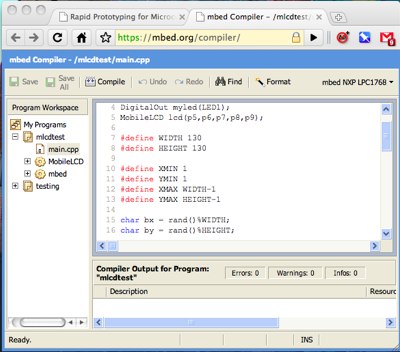The Null Device
2010/3/14
Seen at Maker Faire: Two guys from ARM (the people who designed the CPU in your mobile phone and probably a dozen other devices you own) have designed an amazingly elegant new microcontroller prototyping board, for making electronic gadgets even more easily than with the Arduino. Called mbed, it consists of a board with a USB port and 40 pins. The pins do the usual things (analogue/digital I/O, USB, Ethernet, &c.), but that's not the impressive thing about it; the impressive part is the design of the whole system, which brings web-style agile development to microcontroller-based gadgets.
 When you get an mbed, you plug it into your computer (which may be a Windows PC, a Mac, a Linux box or anything else which can mount USB drives); it then appears as a USB disk, containing one file: a web link. You go to the web link, which directs you to mbed's web site, where you log in or create an account; from then on, you have an integrated development environment in your browser, with source navigation, syntax highlighting and a compiler. Your code is hosted online on mbed's servers (the system uses the Subversion version control system as a store). Create a new project, and you get a "Hello World" program (written in C++) which, by default, flashes one of the mbed board's built-in LEDs. Hit the Compile button, and your browser soon prompts you to download a .bin file of the compiled program. Save it to the mbed card's drive, hit the reset button on it, and your program runs.
When you get an mbed, you plug it into your computer (which may be a Windows PC, a Mac, a Linux box or anything else which can mount USB drives); it then appears as a USB disk, containing one file: a web link. You go to the web link, which directs you to mbed's web site, where you log in or create an account; from then on, you have an integrated development environment in your browser, with source navigation, syntax highlighting and a compiler. Your code is hosted online on mbed's servers (the system uses the Subversion version control system as a store). Create a new project, and you get a "Hello World" program (written in C++) which, by default, flashes one of the mbed board's built-in LEDs. Hit the Compile button, and your browser soon prompts you to download a .bin file of the compiled program. Save it to the mbed card's drive, hit the reset button on it, and your program runs.
That's not all, though; the mbed card can work with a plethora of hardware modules, from Nokia-style LCD displays to GPS units, Bluetooth modems and more. Which is where the next bit of elegance comes in. There exists an ecosystem of modular classes for driving these various devices. To attach a supported device, all you have to do is add the class for it to your project (by pasting the URL of its Subversion repository into a dialog box; the IDE does the rest for you), instantiate it as an object and call its methods. For example, here is code for drawing on a Nokia-style LCD display:
MobileLCD lcd(p5,p6,p7,p8,p9); // the I/O pins
lcd.background(0xffff99);
lcd.foreground(0x000000);
lcd.locate(2,2);
lcd.printf("Hello world\n");
lcd.fill(0,64,128,128, 0xffffff);
mbed is somewhat more expensive than the Arduino (the price quoted was about £45 for the mbed board itself, whereas Arduino-compatible boards go for £13 or so). However, the elegance of the design, its ease of use and sheer niftiness could make it worth the price.
Tattúínárdœla saga, an Icelandic saga telling the story of a fatal conflict between a father and his treacherous son, on which George Lucas' Star Wars films were based:
The story as presented in George Lucas’s films represents only one manuscript tradition, and a rather late and corrupt one at that – the Middle High German epic called Himelgengærelied (Song of the Skywalkers). There is also an Old High German palimpsest known to scholars, later overwritten by a Latin choral and only partly legible to us today, which contains fragments of a version wherein “Veitare” survives to old age after slaying “Lûc” out of loyalty to the emperor, but is naturally still conflicted about the deed when the son of his daughter Leia avenges the killing on him.
Lúkr is saved from drowning by the intercession of Leia and Hani’s men in the Þúsundár Fálkinn. Following this memorable climax, there is an extended lacuna in the manuscript, and the action picks up again with an episode wherein Lúkr rescues Hani and Leia from the corrupt (and grossly obese) Danish merchant Jabbi, a rather comical figure on the whole, and this entire incident is probably to be reckoned an interpolation from a later chivalric saga. Unfortunately the saga shows its repetitive nature at this point, and we once again learn that Veiðari is building, under the auspices of Falfaðinn, a great ship to be named Dauðastjarna in meiri. At a great feast, Lúkr and Hani swear that they will kill Veiðari and Falfaðinn, burn Dauðastjarna, and conquer Kóruskantborg. Their boasts are considered binding and the sworn brothers lead several warships loaded with men to the position of the Dauðastjarna. There Hani is assisted by what the saga describes as “birnir” (literally “bears,” but in context probably to be understood as “Shetlanders” – the German version confusingly seems to understand these as actual bears) in his great assault on Falfaðinn’s fleet, but Lúkr is captured by Veiðari and brought to an audience with Falfaðinn.